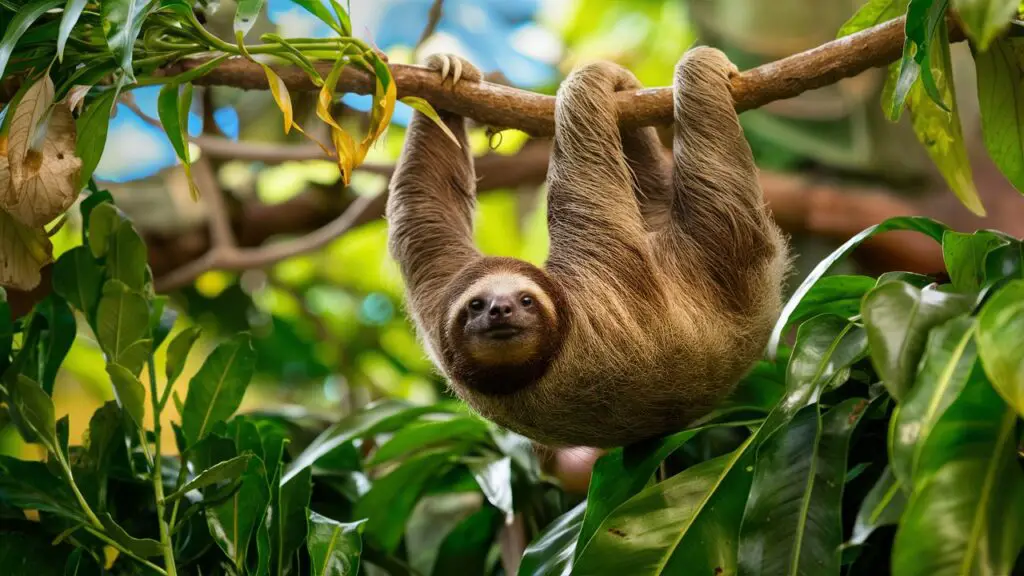As you explore the world of sloths, you will find their natural habitat holds many fascinating facts. In this article, we will take a close look at several key details about where these unique animals live. You will learn specifics on the climate, terrain, and forest areas that sloths call home across parts of Central and South America. Understanding sloth habitat provides insight into how these slow-moving creatures survive and thrive. Join us on an informative journey into the tropical realm of the sloth. Discover what their natural surroundings reveal about their behaviors, adaptations, and lifestyles in the wild.
An Overview of Sloth Habitat Facts
Diet and Feeding
Sloths are herbivores that feed on a diet primarily of leaves, shoots, and fruits. Due to their slow metabolism, sloths do not need to eat often and can survive on a diet of approximately 50 to 60 leaves per week. Sloths have a slow digestive system and it can take up to a month for food to digest. The leaves that sloths feed on are low in nutrients, so they must eat large amounts to gain necessary nutrients.
Sleeping and Activity
Sloths are well-known for being slow, and they are also known for sleeping for up to 15 hours a day. They tend to be most active at night when there are fewer predators. Sloths spend nearly their entire lives in the trees and even sleep while hanging upside down from tree branches. They only descend from the trees about once a week to defecate on the forest floor.
Habitat Range and Environment
Sloths inhabit tropical rainforests in South and Central America. They live in the canopy layer of the rainforest, seldom descending to the forest floor. Sloths require tropical rainforests to survive due to the warm climate and abundance of leaves and trees. Deforestation and habitat destruction threaten sloth populations. As more of their rainforest homes are destroyed, sloths struggle to find adequate food sources and shelter.
To summarize, sloths are well-adapted for living a slow-paced life in the tropical rainforests of South and Central America. They have a specialized diet, sleep schedule, and habitat that allow them to survive and thrive in the dense jungle canopy. However, human activity like deforestation poses serious risks to sloth populations if left unaddressed. Protecting sloths means protecting the diverse rainforests they call home.
The Unique Habitats of the Six Sloth Species
###The Pygmy Three-Toed Sloth The pygmy three-toed sloth inhabits tropical rainforests on the island of Isla Escudo de Veraguas off the coast of Panama. This smallest of all sloth species is found exclusively in the red mangrove forests, where it feeds on the mangrove leaves. The dense foliage provides camouflage and protection for these sloths. However, the limited habitat of only 6.5 square miles makes this species vulnerable to deforestation and climate change.
The Maned Three-Toed Sloth
The maned three-toed sloth can be found in tropical rainforests across central South America in countries including Brazil, Peru, Venezuela, and Guyana. They prefer dense canopies of deciduous forests and evergreen forests, sleeping and feeding high in the treetops. Their long, coarse fur provides excellent camouflage in the dappled light under the canopy. While more widely distributed than the pygmy sloth, habitat loss still poses a threat to this species.
The Pale-Throated Three-Toed Sloth
Pale-throated three-toed sloths inhabit tropical rainforests in central South America, including parts of Colombia, Venezuela, Guyana, Suriname, French Guiana, and northern Brazil. They can be found in a variety of forest types, including evergreen, semi-deciduous, gallery, and montane forests. Like other three-toed sloths, they are almost exclusively arboreal, and they are considered habitat specialists due to their dependence on large, mature trees of specific species. Deforestation, hunting, and the pet trade have reduced populations of this vulnerable species.
Overall, while the six sloth species occupy a variety of rainforest habitats in Central and South America, ranging from the canopies of lowland tropical forests to the treetops of mountain cloud forests, their arboreal nature and specialized diets mean they are particularly sensitive to habitat destruction and disturbance. Protecting remaining tracts of forest and limiting deforestation are crucial steps to ensuring the long term survival of these unique mammals.
Are Sloths Sinful? The Myths and Facts About Sloth Behavior
Sloths are often portrayed as lazy, sluggish creatures. Their slow movements and seemingly inactive lifestyle have given rise to the notion that sloths are indolent and idle. However, this is a misleading myth not supported by the facts.
Sloth Metabolism Demands Limited Activity
Sloths have an extremely low metabolism, about 40% lower than other mammals of comparable size. Their slow metabolic rate means they require little energy to survive and function. Limited activity is a biological necessity to conserve calories, not a product of laziness or slothfulness. Sloths only descend from the canopy about once a week to defecate on the forest floor, further evidencing their energy efficiency.
Sloths Are Well-Adapted For Their Environment
Sloths are specially adapted to life in the treetops. Their slow movements are a result of anatomical adaptations such as curved claws, long limbs, and a loose-jointed skeleton suited for hanging upside down. Sloths spend nearly their entire lives in the trees and are poorly equipped for ground travel, moving at only about 6 meters per minute. Their seemingly slothful behavior is key to their arboreal existence, not a reflection of an idle character.
Sloths Exhibit Social Bonds and Caring Behaviors
In contrast to their sluggish reputation, sloths display social behaviors that demonstrate they are not as slothful or idle as commonly portrayed. Females give birth suspended from tree branches and raise their young for up to two years. Sloths are mostly solitary but occasionally engage in social interactions and even play together. These complex social behaviors show sloths are capable of activity and engagement when necessary for reproduction, parenting, and community.
In summary, while sloths move slowly and sleep often to accommodate their biological needs, they are well-adapted to their ecological niche in the treetops. Their limited activity levels result from physiological necessities, not laziness. Sloths exhibit a range of social interactions and caring behaviors that counter the notion they are idle or slothful creatures. The myth of the sloth as sinfully indolent is not supported by the facts regarding their metabolism, anatomy, environment, and social behaviors. Sloths are not slothful, they are energy-efficient.

Sloth Habitat Destruction: Threats Facing These Arboreal Mammals
As sloths inhabit the tropical rainforests of Central and South America, the biggest threat to their survival is the destruction of their habitat through deforestation and human activity. The sloth populations have declined by 30-50% over the last few decades due to loss of habitat.
Deforestation for Agricultural Purposes
Tropical rainforests are being cleared at an alarming rate to make way for agricultural land, pastures and plantations. As sloths are arboreal mammals that rarely descend from the canopy, loss of trees means loss of their habitat and food sources. This has devastating effects on sloth populations.
Infrastructure Development
Construction of roads, dams, mining sites and human settlements lead to fragmentation of continuous forest tracts. This makes it difficult for sloths to traverse the forest canopy and isolates populations, affecting breeding and genetic diversity. Noise and pollution from such development also disturbs the sloths.
Hunting and Poaching
Although sloths are protected by law in many countries, illegal hunting and poaching still pose a threat. Sloths are hunted both for their meat as well as for the pet trade. The slow movement and docile nature of sloths make them easy targets. Their long claws are also prized as lucky charms. Such hunting has severely depleted sloth numbers in some areas.
Climate Change
Changes in climate such as altered weather patterns and increased frequency of droughts and wildfires damage the tropical rainforests. This loss of habitat due to climate change impacts sloths and other arboreal animals the most. Changes in temperature and weather events also disrupt the ecosystem and availability of food sources for sloths.
In conclusion, sloths face multiple anthropogenic threats that have significantly reduced their populations over time. Protecting large tracts of tropical rainforests, regulating development and human activity in such areas and stricter enforcement of hunting laws can help secure the future of these unique arboreal mammals. Conserving sloth habitat is vital for their long term survival and well-being.
Sloth Habitat Facts FAQ: Your Top Sloth Habitat Questions Answered
Where do sloths live?
Sloths are arboreal mammals found in the tropical rainforests of Central and South America. They inhabit the canopy layer and emergent layer of the rainforest, rarely descending from the trees. Sloths are found in rainforests in countries such as Brazil, Venezuela, Colombia, Panama, Costa Rica, Nicaragua, and Honduras. Their range coincides closely with the distribution of tropical rainforests in the Neotropics.
What kind of forests do sloths prefer?
Sloths prefer tropical rainforests with dense canopies, a warm climate, and high humidity. They tend to inhabit older, primary forests rather than secondary forests. Sloths require large, mature trees with an abundance of lianas, vines, and epiphytes which they use for food, shelter, and camouflage. Their arboreal lifestyle depends entirely on the availability of sturdy trees and a complex network of branches.
What do sloths eat in the rainforest?
Sloths are folivores and consume a diet primarily of leaves, especially the leaves of Cecropia trees. They are known to eat over 50 species of plants. Sloths have a very slow metabolism and a large stomach to ferment the tough, fibrous leaves they eat. They are mostly active at night when the leaves have the highest nutritional content after photosynthesis during the day. Sloths descend to the forest floor once a week to defecate and then climb back up to the canopy.
What natural predators threaten sloths?
The main natural predators of sloths are large predatory birds such as the harpy eagle and crested eagle. These eagles are able to snatch sloths from the canopy and carry them back to their nests. Jaguars and pumas also prey on sloths when they descend to the forest floor. Due to their sedentary nature, sloths are especially vulnerable to predation. Their camouflage and arboreal lifestyle provide some protection, as they are difficult for predators to spot in the dense rainforest canopy.
In summary, sloths inhabit tropical rainforests, preferring large, mature trees in primary forests with an abundance of foliage. They are folivores that feed mostly on leaves, especially Cecropia. While arboreal, sloths face threats from predatory birds and large cats. Their natural habitat and adaptations allow them to evade predators and thrive in the canopy layer.
Don’t Miss a Thing! Enhance Your Wildlife Photography with Ultra-X Night Vision Goggles.
GET NOW!

Conclusion
As we have seen, sloths require specific conditions to thrive in their natural habitats. Their unique adaptations allow them to survive in the treetops of Central and South American rainforests. However, human activity continues to threaten these gentle creatures. We all must do our part to preserve sloth habitat and raise awareness. Simple actions like recycling, reducing energy use, and supporting conservation efforts can help protect sloths for future generations. Though sloths move slowly, destruction can happen quickly. The time is now to spread the word and take steps to safeguard the canopy homes of these fascinating animals.





